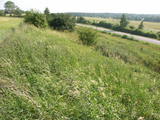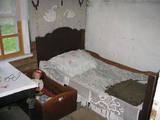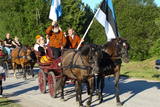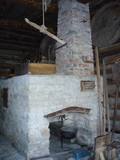| Нo | Название | Описание |
|---|---|---|
|
Taarka Tarõ Köögikõnõ находится на традиционном крестьянском хуторе сету, и помимо традиционных блюд здесь также предлагаются блюда других финно-угорских народов и блюда украинской кухни. |
||
|
This territory protects the shore of the onetime Baltic lake of ice, which most significant part stretches for 10 kilometres on the eastern side of the Grobiņa-Ventspils highway from Kapsēde till Vērgale bus stop. From the top of this ancient shoreline there is a lovely view of the Piejūra lowlands, but no specific viewing areas or information stands have been installed. There are protected species and habitats in the territory. |
||
|
Построенная в начале 19-го века жилая рига с земляным полом - старейшее здание музея. Жилое помещение с комнатами пристроено во второй половине 19-го века. Во дворе есть еще баня по-черному, летняя кухня, амбар, подвал, каретный сарай и столовая (бывший хуторской хлев). Во всех этих помещениях экспонируются старинные орудия труда и предметы обихода. По предварительному заказу предлагаются традиционные деревенские блюда, можно принять участие в работе мастерских. |
||
|
Предлагают размещенный в выработанном карьере пляж с площадкой для отдыха. Две волейбольные площадки, качели, батуты, надувные аттракционы. К радости для самых маленьких имеется «лягушатник». В отдельном карьере предлагается рыбалка - форель, карп, палия, сом. Здесь же на месте можно и приготовить рыбу – поджарить, сварить уху. Для приготовления рыбы предлагаем все необходимое. Рыбалка - круглый год. |
||
|
Маршрут ведет по одному из самых многообразных и красивых прибрежных участков Рижского залива. На нем можно увидеть Рандские луга, которые из-за многообразия произрастающих растений называют латвийским «гербарием» под открытым небом. На маршруте будут участки берега, покрытые валунами различного размера. Не будет недостатка и в красивых и песчанных пляжах. Это единственное место, где на морском побережье Латвии обнажаются песчанные скалы девонского периода. За каждым следующим мысом появляется иной пейзаж! Последние двадцать километров маршрута во время миграции птиц являются «раем» для наблюдателей за птицами. Входит в Северовидземский биосферный заповедник. Maršruta informācija no Latvijas Lauku foruma |
||
|
Туристический конный хутор Тихусе предлагает размещение и конные прогулки(от езды на коляске до конных прогулок). У хутора начинается учебная тропа древней культуры, которая уводит нас в те времена, когда человек связывал себя с силами природы, где можно познакомиться с обычаями и традициями прежних времен. Стены хуторского чайного дома украшают фотографии различных мест Мухумаа, связанных с древней культурой. |
||
|
Kafejnīca "Bura" atrodas Madonas ziemeļdaļā, uz Gaujas un Rūpniecības ielas stūra – pie pilsētas apvedceļa. Kafejnīcā piedāvā plašu ēdienkarti, t.sk. latviešu virtuvi. Banketu zāle, vasarā darbojas āra terase. Piedāvā izbraukuma banketus. Ēka celta guļbūves stilā. Ainaviska vide, laukakmeņi. Latviešu virtuve: Pelēkie zirņi, kartupeļu biezputra ar gaļas krikumiņiem, zemnieku podiņš, siļķe ar mrinētiem sīpoliem un krējumu, maizes zupa, plānās pankūkas. Īpašais ēdiens: Pēc dažādām receptēm gatavots zandarts. |
||
|
Сельский двор предлагает посмотреть домашних животных, домашних птиц и экзотического мару, покататься на пони. Консультации по садоводству и выращиванию мелких животных. Можно приобрести перепелиные яйца, копчености, цыплят и молодую птицу. |
||
|
Talsu vecpilsētā, pašā vēsturiskā centra vidū, atrodas īpaša vieta, kur saplūst lauku miers un pilsētas dzīvīgums. Te vari izbaudīt gan klusumu un nesteidzīgu atmosfēru, gan arī sajust tuvumā esošo ielu dzīves ritmu. Šī māja ir kā radīta romantiskam nedēļas nogales atpūtam divatā — vakarā iekurt kamīnu, iemirdzināt telpu sveču gaismā un baudīt siltu vīna glāzi klusā divvientulībā. Tajā pašā laikā tā lieliski piemērota arī ģimenēm vai draugu kompānijām, kas vēlas pavadīt laiku kopā ērtā un plašā vidē. Villā pieejamas piecas guļamistabas, divas vannas istabas, kvalitatīva gultas veļa un dvieļi, satelīttelevīzija plakanajā ekrānā, ērta ēdamzona, pilnībā aprīkota virtuve, kā arī terase ar skatu uz dārzu. Papildus ērtībām viesiem ir atpūtas zona un kamīns, kas lieliski papildina vietas mājīgumu. |
||
|
RADADA ir radošā darbnīca, kura ierīkota senā ugunsdzēsēju depo. Audumu apdrukas ar saviem orģināliem zīmējumiem rokas sietspiedes tehnikā. Apdrukā apģērbu ar rakstiem un simboliem, kas simbolizē Latvijas dabu, latviešus un to spēku. |
||
|
Находится на Пулеметной горке, которая является одной из самых высоких точек Длинной дюны. Рядом находится памятник доблестным латышским стрелкам, которые потерпели большие потери в ходе Рождественских боев в конце 1916 г. Просматриваются большие лесные массивы до самой Юрмалы и болото Мазтиреля, на котором хорошо выделяется место бывшей узкоколейной железнодорожной насыпи. Входит в Мемориальный парк Рождественских боев, где можно осмотреть музей Мангали, восстановленный “Немецкий вал”, памятники и другие объекты. |
||
|
Saimniecībā tiek audzētas gaļas šķirnes (Suffolkas) aitas un piena šķirnes (Ostfrīzijas) aitas. Ganāpmulka aizsardzībai saimniecībā strādā ar sargsuņiem, Pireneju kalnu suņiem, kas ir pasaulē arī plaši pazīstama suņu šķirne mājlopu un mājputnu apsargāšanai no lielākiem un mazākiem plēsējiem. Saimnieki piedāvā iegādāties premium klases, saimniecībā audzētu, jēru gaļu un aitu piena produktus- Fetas tipa sieru, grilsieru, jogurtu bez piedevām un vairāku veidu saldējumus. |
||
|
In Metsanurme Village Centre you can see restored old threshing barn, limestone barn oven and few tools that were used ages ago. You could be also interested in seeing an outdoor exhibition which focuses on historical agricultural tools. All of this is made to look interesting to not only locals but also visitors. |
||
|
Находится в красивом месте – в южной части острова Пилс возле пешеходного моста через реку Дрикса. |
||
|
Идея центра ‒ укреплять здоровье, питаясь чистыми продуктами, поэтому здесь предлагается насладиться вкусом лишь слегка обработанных и богатых витаминами продуктов. По большей части здесь используют свежие продукты, выращенные в саду при Центре и в окрестных хозяйствах. Специально разработанные курсы питания включают вкусные овощные супы и разнообразные рагу, а также различные каши. Лечебные курсы предполагают не только определенное питание, но и процедуры, и тренировки, которые нужно заказывать заранее. |
||
|
SIA “North Latgallian Firewood” darbības pamatnozare ir mežsaimniecība un kokmateriālu sagatavošana - uzņēmumā nodarbojas ar malkas sagatavošanu un tirdzniecību, kā arī piedāvā malkas gabalošanu un skaldīšanu izbraukumā pie klienta. Uzņēmuma piedāvātie pakalpojumi – malkas sagatavošana, malkas tirdzniecība lielos apjomos, kokmateriālu sagatavošanas pakalpojumi. Brīvajā laikā uzņēmuma īpašnieks restaurē senus motociklus un ir izveidojis plašu retro motociklu un senlietu kolekciju. |
||
|
Корчма находится в историческом центре города Екабпилс, недалеко от Даугавы. Известен экзотическим выбором блюд. Латышская кухня: Сырный салат, суп из боровиков, горшочек с курицей или свининой, клубничный суп с мороженым. |
||
|
Бывшая узкоколейка – сохранилось место станции, багажный склад, жилое
здание начальника станции, а также само «полотно» маленького паровозика.
|
||
|
Братское кладбище – на обочине шоссе Рига
– Вентспилс (А 10). Деревянные мостки ведут до
поминального камня, который установлен в честь
павших во время Первой мировой войны.
|
||
|
«Валдамо» (Vāldamō) - жилое здание желтого цвета и естественным кровельным материалом, построенное в начале прошлого столетия как новое хозяйство. «Вирго» - следующее (к северу) хозяйство за «Валдамо» (Vāldamō). Построено как новое хозяйство в двадцатых годах прошлого столетия. Жилой дом (1930 г.) отличается интересной резьбой по дереву. «Филмани» - следующее (к северу) за «Вирго». Постройка старинного вида возведена в начале ХХ века, как небольшая комната. Увидим «Силкални», если на перекрестке дороги повернем направо, в направлении Питрагса. Это здание желтого цвета, построенное примерно в 1906 г. как небольшая комната. «Норпиедаги» - находится на юге за «Силкални». Коричневого цвета и большего размера, чем предыдущее. Жилое здание примерно в 1906 году, как клеть небольшой комнаты строил активный ливский общественный работник и строитель лодок Дидрикис Волганский(1884 - 1968). 1912 г. здесь родился его сын Эдгарс Валгама, который также был работником ливской культуры и работал священником в Финляндии. «Андули» находятся около ранее упомянутого перекрестка дорог. Одно из крупнейших старых хозяйств поселка и старейший двор, история которого известна с 1680 года, когда он именовался «Кукини». Двор вмещал жилой дом(~ 1909 г.), ригу (1905 г.), клеть (середина XIX в.) и коптильню, построенную из перепиленной лодки. Под частью риги «Андули», которая построена на склоне дюны, находится средневековое, т.н. Чумовое кладбище. «Жоки» - напротив «Андулей» и с другой стороны дороги. Наблюдаемое сегодня здание построено на фундаменте исторического старого хозяйства. В середине XIX в. в «Жоки» находилась первая школа по чтению для ливских детей тогдашних прибрежных поселков Дундаги. Учителем работал лив Ника Полманис (1823 - 1903). «Тилмачи» - следующее (на севере) хозяйство за «Жоки». Сохранилось несколько зданий, которые строились на рубеже XIX – XX столетия: жилой дом коричневого цвета, конюшня и часть клети. Проводя реставрацию жилого здания, хозяин нашел доску с надписью «1825. Курляндская губерния». Упомянутые ранее семь исторических хозяйств и здания в свое время были кандидатами в список мирового культурного наследия ЮНЕСКО. |
||


























